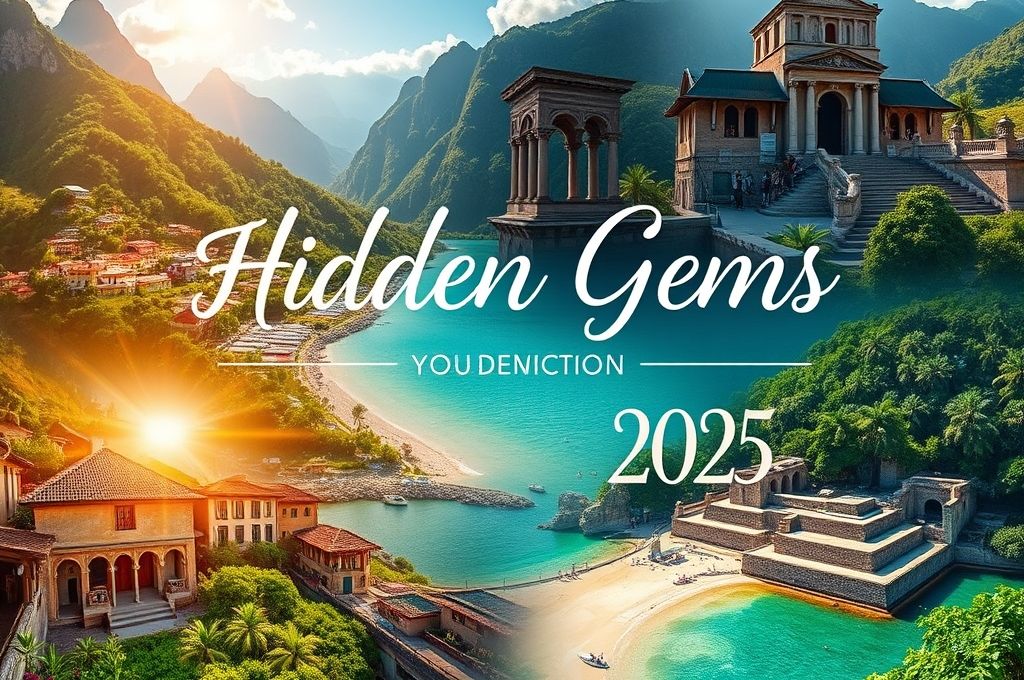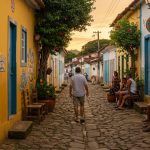Introduction: Beyond the Beaten Path
Imagine stepping off a quiet train platform into a sun-drenched village where cobblestone streets wind past pastel-colored houses, the scent of fresh bread drifting from a corner bakery, and not a single tourist in sight. No long lines, no overcrowded landmarks—just pure, unfiltered travel magic. Sounds like a dream? It doesn’t have to be.
In 2025, more travelers than ever are turning their backs on the usual hotspots and seeking out lesser-known destinations that offer authenticity, charm, and unforgettable experiences—without the crowds. From hidden mountain towns to serene coastal escapes and culturally rich cities flying under the radar, the world is full of hidden gems just waiting to be discovered.
This shift isn’t just about avoiding crowds. It’s about deeper connections—with people, places, and cultures. It’s about sustainability, supporting local economies, and traveling with intention. And let’s be honest: there’s something deeply satisfying about being one of the few who’ve explored a place before it hits the mainstream.
In this article, we’ll take you on a journey to five underrated destinations that deserve a spot on your 2025 travel list. These aren’t just random picks—they’re places with soul, beauty, and unique stories to tell. Whether you’re a solo adventurer, a couple seeking romance, or a family looking for meaningful experiences, these spots offer something special. So pack your curiosity (and maybe your passport), because we’re diving into the world’s best-kept travel secrets.
1. Kotor, Montenegro: Where Mountains Meet the Sea
Tucked along the dramatic Bay of Kotor in the Adriatic Sea, this medieval town feels like a scene from a fairy tale. Surrounded by towering limestone cliffs and overlooking shimmering blue waters, Kotor is Montenegro’s answer to Dubrovnik—only without the overwhelming tourist traffic.
While nearby Croatia draws millions each year, Kotor remains refreshingly under the radar. And yet, it offers everything you’d want in a coastal escape: ancient city walls, charming alleyways, historic churches, and breathtaking views from the 1,350-step climb up to San Giovanni Fortress. The reward? A panoramic vista that stretches across the bay and makes every step worth it.
Why it’s perfect for 2025:
Montenegro is increasingly becoming a hotspot for eco-conscious travelers. The country has committed to sustainable tourism, with protected natural parks and a focus on low-impact development. Kotor, though historic, is embracing green initiatives—from electric boat tours to locally sourced dining.
What to do:
- Wander the UNESCO-listed Old Town, where Venetian architecture meets Balkan charm.
- Take a kayaking tour of the bay at sunrise.
- Visit the nearby village of Perast, home to two tiny islands built by locals over centuries.
- Sample pršut (Montenegrin prosciutto) and local wine at a family-run konoba (tavern).
Pro tip: Visit in early spring (April–May) or late September to avoid cruise ship crowds and enjoy mild weather.
Kotor proves that you don’t need mass tourism to feel the magic of the Mediterranean. It’s intimate, authentic, and utterly captivating.
2. Hoi An’s Quiet Cousin: Tra Que Village, Vietnam
Everyone’s heard of Hoi An—the lantern-lit riverside town famous for tailors, ancient houses, and bustling markets. But just a 15-minute bike ride away lies Tra Que Vegetable Village, a lush, green oasis where time moves slowly and farming is an art form.
This humble farming community has been growing organic herbs and vegetables for over 200 years using traditional methods passed down through generations. Here, farmers rise at dawn to tend their plots with hand tools, using compost made from seaweed pulled from the nearby coast. The result? Some of the freshest, most flavorful produce in Vietnam.
Why it’s a must-visit in 2025:
As travelers seek more meaningful, immersive experiences, agri-tourism is on the rise. Tra Que offers a rare chance to get your hands dirty—literally. Many homestays and local guides offer “farmer for a day” programs, where you can plant, harvest, and even cook with your fresh-picked bounty.
Unique experiences:
- Join a sunrise farming session and learn how to plant basil or mint.
- Take a cooking class using ingredients you’ve just harvested.
- Enjoy a meal in a farmer’s home, served on a mat under a thatched roof.
- Rent a bike and explore the network of quiet paths through rice paddies and herb gardens.
Sustainability in action:
Tra Que is a shining example of how tourism can support rural communities without disrupting their way of life. Your visit directly benefits local families and helps preserve traditional farming practices in the face of urbanization.
Compared to the bustling streets of Hoi An, Tra Que feels like stepping into a slower, more peaceful world. It’s not just a side trip—it’s a reminder of the beauty in simplicity.
3. Sintra, Portugal — But Skip the Crowds: Explore Colares Instead
Sintra is magical—no doubt about it. Its colorful palaces, misty forests, and fairy-tale vibes make it one of Europe’s most enchanting towns. But with over 3 million visitors a year, it’s also overcrowded, expensive, and often exhausting.
Enter Colares, a quiet village nestled just west of Sintra, where vineyards roll down to meet the Atlantic Ocean. This is where Portugal’s rare Ramisco wine is made, in a region so unique it’s one of the most wind-exposed wine areas in the world. The sandy soil, cooled by ocean breezes, creates a terroir unlike any other.
Why Colares shines in 2025:
As wine tourism grows globally, Colares offers an off-the-radar alternative to more famous regions like Douro or Alentejo. And unlike industrial vineyards, here you’ll find small, family-run wineries where the owners greet you like old friends.
Don’t miss:
- A visit to Adega Viúva Gomes, a historic winery producing Ramisco since 1890.
- A coastal hike from Colares to Praia da Ursa, one of Portugal’s most dramatic beaches, framed by towering cliffs.
- Tasting local wines paired with enchidos (cured sausages) and goat cheese at a rustic quinta (farmhouse).
- Exploring the Sintra-Cascais Natural Park without the crowds.
A local secret: Stay in a converted wine press house or a countryside guesthouse for a truly immersive experience.
Colares isn’t just a wine destination—it’s a slow travel paradise. It invites you to linger, breathe deeply, and savor the rhythm of rural life. In a world that’s always rushing, that’s a rare gift.
4. The Faroe Islands: Europe’s Best-Kept Secret Above the Arctic Circle
Perched halfway between Iceland and Norway, the Faroe Islands are a remote archipelago of 18 volcanic islands where waterfalls tumble directly into the sea, sheep outnumber people, and the wind tells stories.
Long overlooked by mainstream tourism, the Faroes are gaining quiet attention—and for good reason. In 2025, they’re emerging as a top destination for nature lovers, photographers, and adventure seekers who crave raw, untouched landscapes.
What makes them special:
- Over 90% of the islands’ energy comes from renewable sources, and the government is actively managing tourism to protect fragile ecosystems.
- There are no fast-food chains, no traffic lights, and only one stoplight in the entire country.
- The Faroese people speak Faroese, a Nordic language so rare it’s spoken by only 70,000 people worldwide.
Top experiences:
- Hike to Kallur Lighthouse on Kalsoy Island—one of the most photographed views on Earth.
- Take a boat tour to Mykines, home to thousands of puffins during breeding season (May–July).
- Stay in a traditional grass-roofed house in the village of Gjógv, where the sea flows beneath the town.
- Try ræst kjøt (fermented lamb) or fresh line-caught fish at a local hestakjøt (not horse meat—don’t worry! It’s a homophone!).
Sustainable travel tip: The Faroe Islands launched the “Sheep View” project, where backpacks with cameras are strapped to sheep to livestream remote areas—helping promote tourism while minimizing human impact.
The Faroes aren’t easy to get to, but that’s part of their charm. They reward the curious, the patient, and the respectful traveler. In 2025, as overtourism plagues more accessible destinations, the Faroes stand as a model of eco-conscious, low-volume travel done right.
5. San Pedro de Atacama, Chile: Desert Wonders Beyond the Ordinary
When you think of Chile, you might picture Patagonia or Santiago. But deep in the northern reaches of the country lies San Pedro de Atacama, a high-altitude oasis in the world’s driest desert—and one of South America’s most surreal landscapes.
At 2,400 meters (7,900 feet) above sea level, this small adobe town is the gateway to salt flats, geysers, alien-like rock formations, and star-filled skies so clear they’ve drawn astronomers from around the world.
Why it’s underrated:
Despite its natural wonders, San Pedro remains less visited than other South American hotspots like Machu Picchu or the Galápagos. It’s not the easiest place to reach, but for those who make the journey, the rewards are otherworldly.
Must-do adventures:
- Watch the sunrise at El Tatio Geysers (one of the highest geyser fields on Earth).
- Float effortlessly in the Cejar Lagoon, a salt lake denser than the Dead Sea.
- Explore Valle de la Luna (Moon Valley), where wind-carved dunes and salt caves create a Martian landscape.
- Stargaze with a local guide using professional telescopes—light pollution is nearly nonexistent.
Cultural depth:
The region is home to the Atacameño people, indigenous communities with a rich heritage dating back thousands of years. Visiting their villages and learning about their traditions adds a powerful human dimension to the natural beauty.
Travel responsibly:
Due to its fragile ecosystem, San Pedro has strict water conservation rules. Many lodges use solar power and limit guest numbers. As a visitor, you can help by choosing eco-certified tours and respecting local guidelines.
In 2025, as travelers seek destinations that combine adventure, culture, and sustainability, San Pedro de Atacama stands out as a true hidden gem—one that feels like another planet, yet is deeply connected to ancient human roots.
Beyond the Checklist: Why Hidden Gems Matter
So why are these places gaining attention now? And why should you consider them over more famous destinations?
1. The Overtourism Crisis
Cities like Venice, Barcelona, and Bali are struggling under the weight of mass tourism. Locals are being priced out, ecosystems are degrading, and the visitor experience is often diminished. In 2025, travelers are voting with their feet, choosing quieter, more sustainable alternatives.
2. The Rise of “Slow Travel”
More people are trading checklist tourism (“I’ve been to Paris, Rome, and Athens”) for deeper, longer stays. They want to connect, not just consume. Hidden gems naturally support this mindset—they’re places where you can slow down, engage with locals, and truly absorb the culture.
3. Social Media’s Double-Edged Sword
While Instagram has made some destinations too popular, it’s also helped uncover lesser-known spots. A single viral photo of a Faroese waterfall or a quiet beach in Montenegro can spark interest—but if managed well, this can lead to responsible growth.
4. Personal Fulfillment
There’s a unique joy in discovering a place before it becomes “the next big thing.” It feels more authentic, more adventurous. You’re not just following a trend—you’re writing your own story.
As travel writer Pico Iyer once said, “We travel, initially, to lose ourselves; and we travel, next, to find ourselves.” Hidden gems offer both: the thrill of discovery and the chance to reconnect with what travel should be—meaningful, transformative, and human.
How to Travel Responsibly to Underrated Destinations
Finding hidden gems is exciting, but with that comes responsibility. When you’re one of the few visitors in a small town or fragile ecosystem, your impact matters more.
Here are five practical tips to ensure your trip benefits the place you visit:
- Stay Longer, Visit Fewer Places
Instead of hopping from city to city, pick one destination and immerse yourself. Rent a local apartment, shop at farmers’ markets, and learn a few phrases in the local language. - Support Local Businesses
Eat at family-run restaurants, book tours with local guides, and buy souvenirs from artisans—not imported trinkets. - Respect Nature and Culture
Stay on marked trails, avoid touching wildlife, and ask permission before photographing people. Remember: you’re a guest. - Travel Off-Season
Visit in shoulder or low season (like April or October) to reduce pressure on infrastructure and enjoy better prices and fewer crowds. - Leave No Trace
Carry a reusable water bottle, avoid single-use plastics, and pack out what you pack in—especially in remote areas.
By following these principles, you help ensure that these hidden gems stay beautiful, authentic, and accessible for future travelers.
Final Thoughts: Your Next Adventure Awaits
The world is full of wonder—but sometimes, the most magical places aren’t the ones plastered across travel magazines. They’re the quiet villages, the rugged coastlines, the high-altitude deserts, and the green valleys where life moves at a different pace.
In 2025, as we continue to rethink how and why we travel, hidden gems offer a path forward—one that’s more sustainable, more meaningful, and infinitely more rewarding.
Whether it’s sipping wine in Colares as the sun sets over the Atlantic, hiking a Faroese cliff at dawn, or learning to farm in a Vietnamese village, these experiences don’t just fill your camera roll. They fill your soul.
So this year, dare to go beyond the guidebooks.
Swap the crowded landmarks for the road less traveled.
Say yes to the unknown.
Because the best trips aren’t just about where you go—they’re about who you become along the way.
Now It’s Your Turn!
Have you visited any of these underrated destinations? Or do you have a hidden gem of your own to share?
👉 Drop a comment below and tell us about your favorite off-the-radar spot.
📌 Share this article with a fellow traveler who’s ready to explore something new.
✈️ And most importantly—start planning your 2025 adventure. The world’s quietest, most beautiful places are waiting for you.

Danilo Ferreira is a passionate entrepreneur, travel, and financial freedom enthusiast, always seeking new ways to expand his horizons and live with purpose. Driven by a high-performance mindset, he combines discipline and curiosity to achieve ambitious goals, exploring the world while building projects that reflect his vision of independence and continuous growth.







